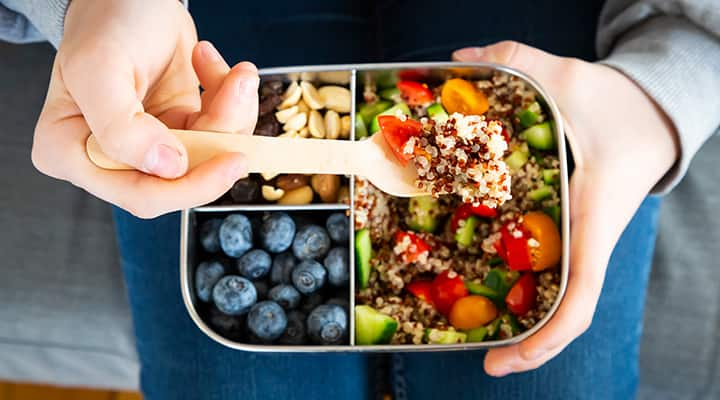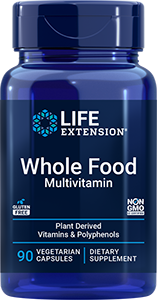
Flexitarian Diet: Pros & Cons
Published: January 2022
Vegetarian diets have been linked to many health benefits. But if piling up your plate with leafy greens and forgoing the savory taste of a hamburger topped with the gooey goodness of cheese isn’t for you, then you may want to try the flexitarian diet.
Is this a healthy diet, and how do you follow the plan? We asked registered dietitian Holli Ryan, RD, LD/N, to explain the benefits of the flexitarian diet.
“The key aspect about this eating pattern is that it encourages a variety of foods rather than establish restrictions on what you add to your plate,” Ryan explained. “This makes it a more sustainable way of eating.”
What is a flexitarian diet?

If you’re thinking the flexitarian diet sounds like flexible and vegetarian combined, you’re on point! It’s a hybrid diet that focuses on adding more plant-based foods to your meals while still enjoying meats and other animal products in moderation, Ryan explained.
This eating pattern has no clear-cut rules or a definite number of calories, so you can say it’s more of a lifestyle than a diet. The focus is on eating a semi-vegetarian, balanced diet by following these five principles:
1. Choose mostly fruits, vegetables, legumes and whole grains (check out the flexitarian food list below).
2. Always choose the most natural and least processed form of your foods.
3. Your primary protein source comes from plants instead of animals.
4. Be flexible by occasionally eating meats, seafood, and other animal products, like dairy and eggs.
5. Limit highly processed foods, added sugars and baked goods.
Is the flexitarian diet healthy?
The flexitarian diet incorporates principles that align with the 2020-2025 Dietary Guidelines for Americans, which emphasizes the importance of eating daily servings of nutrient-dense foods and beverages that provide you with the nutrients your body needs to stay healthy.
Studies show that this eating pattern also supports other aspects of whole-body health, such as heart health and promoting a healthy inflammatory response.
Can you lose weight on flexitarian diet?
Even though this eating pattern wasn’t designed to help you shed extra pounds, it may help you maintain a healthy weight. That’s because a flexitarian diet encourages you to add more wholesome, nutrient-dense and antioxidant-rich foods to your daily meals, while encouraging eating less sugar, saturated fats, and processed foods.
According to Ryan, the emphasis on plant-based foods also helps you meet your fiber needs and support a healthy microbiome (which includes trillions of microorganisms that live in your gut), encouraging satiety—which, in turn, helps you stay at a healthy weight.
What are the disadvantages of a flexitarian diet?

When you start eating a flexitarian diet, you’ll limit your intake of meat and other animal products. As a result, you may develop a nutrient deficiency. It all depends on the type of foods you cut out and whether you’re replacing those nutrients with the right plant-based foods or supplements.
Here are some possible nutrient deficiencies on the flexitarian diet.
1. Vitamin B12
Essential for your nervous system and more, this vitamin is primarily found in meats and other animal products. But you can complement your food choices with a vitamin B12 supplement.
2. Zinc
Your body uses zinc to support your immune system. But the zinc found in different plant sources is not as bioavailable as animal sources would be. Here’s where a multivitamin that offers a healthy dose of vitamins and minerals can help.
3. Iron
Limiting your meat intake can lead to iron deficiency. But you can help your body better absorb this mineral by adding foods rich in vitamin C.
4. Calcium
Less intake of dairy products could lead to a calcium deficiency. But you can fight that by eating enough broccoli, soybeans, spinach, and other leafy greens—all of which are rich sources of calcium.
5. Omega-3 fatty acids
Omega-3 fatty acids are essential for brain and heart health. Complement your food choices by adding an EPA/DHA or an algae-derived DHA to your regimen.
Explore Our Best Weight Management Supplements
Flexitarian diet food list: What do you eat on a flexitarian diet?

When going “flexitarian,” you focus on incorporating more foods like fruits, vegetables, dairy, whole grains, and a variety of protein foods, like nuts, seeds, and legumes, as well as lean meat, poultry, and seafood. When possible, choose in-season produce, added Ryan.
Flexitarian grocery list
1. Plant protein:
Soy, tempeh, tofu, chickpeas, edamame, lentils, beans2. Non-starchy vegetables:
Leafy greens, bell peppers, brussels sprouts, cabbage, broccoli, cauliflower, bok choy3. Starchy vegetables:
Sweet potatoes, potatoes, peas, squash, corn4. Fruits:
Apples, bananas, berries, oranges, kiwi, papaya5. Whole grains:
Quinoa, teff, buckwheat, farro6. Nuts, seeds, and healthy fats:
Almonds, walnuts, pecans, cashews, pistachios, pumpkin seeds, sunflower seeds, chia seeds, flaxseeds, avocados, olive oil, coconut oil7. Herbs and spices:
Rosemary and basil, saffron, ginger, garlic, turmeric, sage, cinnamon are just a few examples8. Beverages:
Sparkling or still water, non-sugary vegetable or fruit juices, tea and coffeeWhat animal products are ok to eat on the flexitarian diet?
1. Eggs—
Free-range or pasture-raised
2. Poultry—
Free-range or pasture-raised3. Meat—
Choose grass-fed or pasture-raised red meats4. Fish—
Choose wild-caught salmon, mackerel, tuna, or trout5. Dairy—
organic, sourced from grass-fed or pasture-raised animalsWhat not to eat on the flexitarian diet?
1. Processed meats:
Such as bacon, sausage, bologna2. Refined carbs:
White bread, rice, white pasta, bagels, croissants3. Fast foods:
Fries, burgers, chicken nuggets, and other fried foods4. Added sugars and sweets:
Soda and sugary beverages, candy, donuts, cookies, cakes, ice creamPro-tip: Homemade meals are healthier alternatives to some of these foods. If you have a sweet tooth, you can enjoy healthy alternatives without completely cutting them out from your meals. But moderation is imperative.
Are diets always good for your health?
To follow a diet plan, or to eat a balanced diet, that is the question.
It turns out that having balanced meals does wonders for your health…following a diet plan, not so much. “I’m more of an advocate for healthy eating patterns versus dieting,” Ryan said. “The distinction is that diets can be overly restrictive and create a negative relationship with food, and it’s not sustainable long-term. A flexitarian eating pattern gives you the best of both worlds.”
8 ways to stay healthy all year round

A flexitarian approach to eating is just one way to stay healthy. Here are eight steps you can follow and enjoy doing every day.
Regular body movement—
Developing a regular routine in which you engage in full-body movement, increase your heart rate, and work up a sweat is terrific for your brain and overall well-being. Dedicate 30 minutes of your day, at least five days a week, to get the many health benefits of exercise. Pro-tip: Include at least two days of light weightlifting or resistance training to target and tone major muscle groups.Eat the rainbow—
Make your meals as wholesome and colorful as possible. Adding foods like purple cabbage, red bell peppers, brussels sprouts, mushrooms, red kidney beans, and sweet potatoes brings texture, flavor, and nutrients to every dish.Positive self-talk—
Your inner dialogue can set the tone for your day and affects your overall health. If “tough love” isn’t getting you the results you’re looking for, then flip the script! Choose kind thoughts, practice gratitude, and honor your physical and emotional health.Stress management—
That “flight or fight” stress response is a biological process designed to keep you alive; when left unmanaged, it can impact your health. End your days with yoga, meditation, or a hobby you enjoy. You can also supplement with adaptogens and nootropics to promote a calmer mood and a sharper mind.Stay hydrated—
Your body is about 60 percent water, and staying hydrated is essential for your body to perform optimally. How much water you drink depends on your lifestyle and unique needs, but aiming for at least 2L of water a day is a good benchmark.Stay on top of your health—
Own your wellness and empower yourself to live your best life by getting annual lab tests and checkups. This will shed light on any aspect of your health that needs addressing.Get restful sleep—
Getting quality sleep lets your body recharge and decompress, benefitting your mood, memory, health, and more. Plus, you start your days feeling refreshed and ready for whatever comes your way.Nutritional plan—
Ensure your body gets enough of the vitamins, minerals, and other nutrients it needs. Speak with your doctor and dietitian/nutritionist to build a strategic nutritional plan that complements your wellness journey.Lasting change takes time, practice, and patience. Start slowly: choose one item from the list and commit to it for six months—this will help you build the foundation to stay healthy from head to toe.
References
- Craddock, C Joel et al. “Vegetarian-Based Dietary Patterns and Their Relation with Inflammatory and Immune Biomarkers: A Systematic Review and Meta-Analysis.” Adv Nutr., May 2019, https://pubmed.ncbi.nlm.nih.gov/30947338/
- Derbyshire, J Emma. “Flexitarian Diets and Health: A Review of the Evidence-Based Literature.” Front Nutr., January 2017, https://pubmed.ncbi.nlm.nih.gov/28111625/
- Dix-Taub, Bonnie, RDN. “What Is a Flexitarian Diet? What to Eat and How to Follow the Plan.” Everyday Health, January 2019, https://www.everydayhealth.com/diet-nutrition/diet/flexitarian-diet-health-benefits-food-list-sample-menu-more/
- Huang, Ru-Yi et al. “Vegetarian Diets and Weight Reduction: A Meta-Analysis of Randomized Controlled Trials.” J Gen Intern Med., January 2016, https://pubmed.ncbi.nlm.nih.gov/26138004/
- Leitzmann, Claus. “Vegetarian Diets: What Are the Advantages?” Forum Nutr., 2005, https://pubmed.ncbi.nlm.nih.gov/15702597/
- Satija, Ambika et al. “Plant-Based Diets and Cardiovascular Health.” Trends Cardiovasc Med., October 2018, https://pubmed.ncbi.nlm.nih.gov/29496410/
- Streit, Lizzie, MS, RDN, LD. “The Flexitarian Diet: A Detailed Beginner’s Guide.” Healthline, December 2019, https://www.healthline.com/nutrition/flexitarian-diet-guide
- “A Flexitarian Approach to Sustainable Healthy Diets.” YouTube. May 2021, https://www.youtube.com/watch?v=NI1eaK8Nf8s
- “Dietary Guidelines for Americans.” https://www.dietaryguidelines.gov/
- “Iron.” Data on file.
- “Omega-3 Fatty Acids.” Fact Sheet for Health Professionals, National Institutes of Health, https://ods.od.nih.gov/factsheets/Omega3FattyAcids-HealthProfessional/
- “Positive thinking: Stop negative self-talk to reduce stress.” Mayo Clinic, January 2020, https://www.mayoclinic.org/healthy-lifestyle/stress-management/in-depth/positive-thinking/art-20043950
- “Vitamin B12.” Fact Sheet for Health Professionals, National Institutes of Health,https://ods.od.nih.gov/factsheets/VitaminB12-HealthProfessional/
- “Water: How Much Should You Drink Every Day?” Mayo Clinic, October 2020, https://www.mayoclinic.org/healthy-lifestyle/nutrition-and-healthy-eating/in-depth/water/art-20044256
Like what you read?
Please subscribe to get email updates on this blog.





